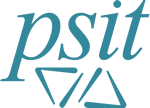The Systemic Concept of Analysis
PSIT uses registration of positive perceptions in three different dimensions and fifteen factors as data input. These three dimensions have the systemic concept as a theory base as being a set of interrelated and interdependent parts that, together, forms a Unit with certain goal and function, bigger than the sum of parts. These dimensions when at plain interaction and power, what means, factors at maximum score, generates at the organization reaching a 4ª dimension or High Performance level, driving all participants to reach maximum business results.
a) The PSIT default dimensions that represents the systemic concept are: Action, Connection and Knowledge.
b) Each of these dimensions are connected to five factors. These, in turn, are associated to organizational goals and priorities and can be adopted depending each company business strategy.
c) In an illustrative form, the systemic concept is represented by a trihedral or pyramid with equilateral triangle faces where its three corners represent the three dimensions and the one on the top, the high performance one.
d) Based on the concept, depending on each dimension and its five factors score, a secondary trihedral is formed and the more five factors get improved the more the superior vertices will move towards a maximum value.
e) Factors scores are based on perceptions going through zero to five getting updated by the PSIT algorithm.
f) The registration or perception mapping are based on individual contribution achieved during people daily quotidian interactions where the absent of positive perception represents the neutral or negative bias.
Perceptions
It is a brain function that assigns meaning to sensorial stimulus, having its beginning in attention, which is nothing more than a process of selective observation and that unfolds into interpretations. As a new information is acquired, new perceptions are dynamically altered, allowing situations to be viewed in different ways. Through perception, the individual organizes and interprets their sensory impressions to assign meaning to a situation, consisting in the acquisition, interpretation, selection and organization of the information obtained by the senses.
The PSIT consists of recording perceptions of the contributions of their professional interactions.
Positive Psychology
Positive Psychology has been described in many ways and forms, but the most classical definition is this: "Positive psychology is the scientific study of what makes life most valuable" (Peterson, 2008). In short, it can be understood as a scientific approach that studies human thoughts, feelings, and behavior, focusing on strengths rather than weaknesses, building good in life rather than repairing evil and withdrawing from people's lives the "average" attitude "and incorporating" big "thinking. Positive psychology focuses on positive events and life influences, including positive experiences (such as happiness, joy, inspiration and love), positive states and traits (such as gratitude, resilience, and compassion), positive institutions (applying positive principles within organizations and entire institutions). As a study, positive psychology spends most of its time thinking about themes such as strength of character, optimism, satisfaction with life, happiness, well-being, gratitude, compassion (as well as self-pity), self-esteem and self-confidence, hope. and elevation. These topics are studied to learn how to help people thrive and live better lives.
Feedforward
Feedfoward means giving ideas and guidance to the professional for its improvement, the pillars of action are: the present, the future and the positivity focused on maximizing the potentialities. The basis of the guidelines is focused on helping to outline the potential and strength of people. Positive reinforcement enhance the likelihood of repetition of behaviors or practices recognized by others, as unconsciously, all people seek recognition of their actions and make it spontaneously on a daily basis. In addition, and especially, it removes the vices of a performance evaluation with a view of the rearview, looking at the past, since in feedforward we are dealing with present performance and the other perception about contributions is fundamental to give direction in our daily life, humanizing relationships.
As we focus on the positive aspects, we´ll evaluate gaps by the absence of the positive rather than by the emphasis on the negative, which radically changes the analysis view.
The dynamism of this evaluation process makes it possible to see the individual in all its facets, since we are facing social interactions and individual perceptions and in this, the maturing of the team passes through the transparency of the results without exposing those involved, since the mapping is a statistical result . The goal is to emphasize the positive aspects within a professional performance since we have been acculturated to look at the negative, it is a paradigm shift where, we focus on what we do well and where we are admittedly good!
The company that strengthens the positive aspects of its teams will surely have a better performance of its professionals, because when we make what we are good we can, with some commitment, reach excellence, while, we will never be excellent in our gaps, probably as these are activities that they are not part of our nature. Bringing the best from the professional in your work environment, coupled with your role within the organization, will bring high performance to the company with the least effort of the individual.
Feedback versus Feedforward.
Líderes devem constantemente fornecer suas impressões e suas análises da performance da equipe através de sessões de Feedback. Feedforward é uma variação do Feedback que tem o foco em desenvolvimento para o futuro calibrando desta forma a performance.

